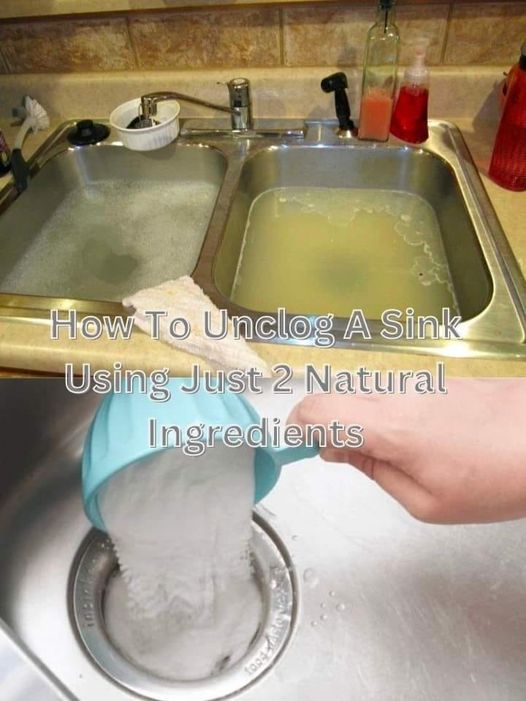We’ve all been there: a slow-draining sink that eventually turns into a full-blown clog, refusing to let water pass through. If you’re like me, you’ve probably tried a myriad of solutions, from harsh chemical drain cleaners to calling in the plumber—only to be left frustrated and out of pocket. But what if I told you that the solution to your problem lies in two simple, natural ingredients that are probably sitting in your pantry right now? Yes, you heard that right! You can easily unclog your sink using just vinegar and baking soda.
The Kitchen Sink Drama
In my household, the kitchen sink is notorious for its finicky behavior. I’ve learned the hard way that certain items—like rice, eggshell fragments, and vegetable peels—are strictly off-limits. Despite my best efforts to prevent clogs, there was one particularly memorable incident that pushed me to explore natural remedies. I had foolishly decided to throw several leftover cilantro stalks down the garbage disposal. To my dismay, the disposal functioned, but the water stubbornly remained stagnant. Faced with the possibility of a hefty plumber’s bill, I turned to an age-old trick I found online, hoping for a miracle.
The Power of Baking Soda and Vinegar
To my surprise, this simple concoction of baking soda and vinegar worked wonders. Not only did it save me from the hassle of dismantling pipes, but it also left my sink flowing freely once again. What makes this method so effective? It all comes down to chemistry. When baking soda (a base) meets vinegar (an acid), they react to form carbon dioxide gas and water. This bubbling reaction helps to break apart the clog, while the hot water flushes it all down the drain, leaving your pipes clean and clear.
What You’ll Need:
- 1 cup of white vinegar: A common household item, vinegar is known for its acidic properties that can dissolve mineral deposits, grease, and grime.
- 1 cup of baking soda: A versatile ingredient, baking soda is a mild alkali that can dissolve dirt and grease in water.
- Sink stopper or drain plug: This is crucial for trapping the reaction inside the pipes, ensuring it works on the clog and not in the open air.
- Boiling water: The final step in the process, boiling water helps to flush out the dissolved gunk and clears the pipes.
Step-by-Step Guide to Unclogging Your Sink:
Step 1: Add Vinegar and Baking Soda
Begin by pouring one cup of white vinegar directly into the sink drain. Immediately after, sprinkle one cup of baking soda down the drain. The reaction between these two ingredients will create a fizzing, bubbling effect that you can both see and hear. Quickly cover the drain with a stopper or plug to keep the reaction contained within the pipes. This will ensure that the fizzing action works directly on the clog, breaking it down effectively.
Step 2: Let It Work Its Magic
Once the fizzing has subsided, let the mixture sit in the drain for at least 30 minutes. This waiting period is crucial as it allows the solution to penetrate deep into the clog, breaking apart any buildup of grease, soap scum, or food particles.
Step 3: Flush with Boiling Water
After 30 minutes have passed, carefully remove the stopper and pour a kettle or pot of boiling water down the drain. The hot water will help to wash away any remaining residue, leaving your pipes clean and free-flowing.
Why This Method Is a Game-Changer
What makes this method so powerful is its ability to tackle clogs without the need for harsh chemicals. Many commercial drain cleaners contain lye or sulfuric acid, which can be corrosive to your pipes and harmful to the environment. In contrast, vinegar and baking soda are both eco-friendly and safe for your plumbing system. Plus, they’re incredibly cost-effective—especially when compared to the price of a plumber’s visit!
Extra Tips for Preventing Future Clogs:
- Be Mindful of What Goes Down the Drain: Avoid disposing of fibrous vegetables, coffee grounds, or greasy substances down your kitchen sink. These items are common culprits when it comes to blockages.
- Regular Maintenance: Periodically flush your drains with a mixture of vinegar, baking soda, and boiling water, even if you don’t have a clog. This preventative measure can help to keep your pipes clean and prevent buildup.
- Use a Drain Strainer: A simple strainer can catch food particles and debris before they have a chance to enter your pipes, reducing the likelihood of clogs.
- Grease Disposal: Instead of pouring grease down the sink, let it solidify in a container and dispose of it in the trash. Grease is a major contributor to clogged drains and can be difficult to remove once it hardens in your pipes.
A Natural Solution for a Common Problem
Clogged sinks are a common issue in many households, but with this simple, natural solution, you can keep your drains flowing smoothly without the need for expensive and potentially harmful chemical cleaners. The next time your sink decides to act up, give this method a try—you might just find that it’s the only solution you’ll ever need!
